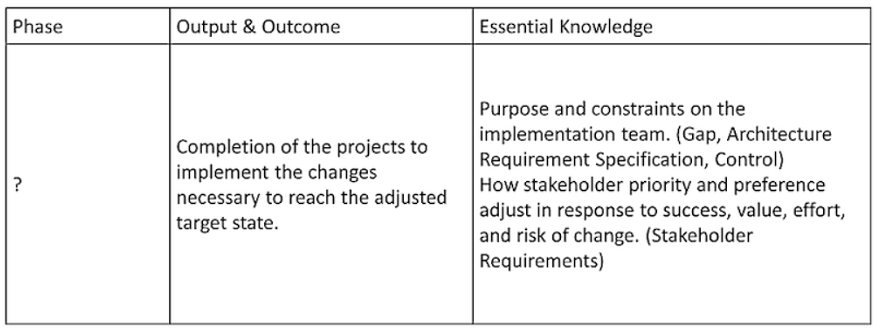Curious about Actual The Open Group TOGAF Certifications (OGEA-101) Exam Questions?
Here are sample The Open Group TOGAF Enterprise Architecture Part 1 (OGEA-101) Exam questions from real exam. You can get more The Open Group TOGAF Certifications (OGEA-101) Exam premium practice questions at TestInsights.
What does the TOGAF ADM recommend for use in developing an Architecture Vision document?
Correct : D
Business scenarios are a technique recommended by the TOGAF ADM for use in developing an Architecture Vision document12. Business scenarios are a means of capturing the business requirements and drivers, the processes and actors involved, and the desired outcomes and measures of success34. Business scenarios help to create a common vision and understanding among the stakeholders, and to identify and validate the architecture requirements . Business scenarios also provide a basis for analyzing the impact and value of the proposed architecture. Reference:
* The TOGAF Standard, Version 9.2 - Phase A: Architecture Vision - The Open Group
* TOGAF Standard --- Introduction - Phase A: Architecture Vision
* The TOGAF Standard, Version 9.2 - Definitions - The Open Group
* Business Scenarios - The Open Group
* [The TOGAF Standard, Version 9.2 - Architecture Requirements Specification - The Open Group]
* [The TOGAF Standard, Version 9.2 - Architecture Vision - The Open Group]
* [The TOGAF Standard, Version 9.2 - Business Transformation Readiness Assessment - The Open Group]
Start a Discussions
Refer to the table below:

Which ADM Phase does this describe?
Correct : B
The table describes the output, outcome, and essential knowledge of an ADM phase that oversees the implementation of changes necessary to reach the adjusted target state. This corresponds to Phase G, also known as Implementation Governance, which ensures that the architecture defined in earlier phases is realized, and it oversees the development and implementation of projects to align with this architecture. The essential knowledge required during this phase includes understanding constraints on the implementation team and adjusting stakeholder priority and preference in response to success, value, effort, and risk of change. Reference: TOGAF Version 9.1 - 1
Start a Discussions
Which phase of the ADM has the purpose to develop an Enterprise Architecture Capability?
Correct : B
According to the TOGAF Standard, 10th Edition, the Preliminary Phase of the Architecture Development Method (ADM) has the purpose to develop an Enterprise Architecture Capability 1. An Enterprise Architecture Capability is the ability of the organization to perform the activities and tasks related to Enterprise Architecture, such as defining the scope, principles, vision, governance, and stakeholders of the architecture. The Preliminary Phase also establishes the architecture framework, the architecture repository, the architecture tools, and the architecture team 1. The other options are not correct, as they have different purposes in the ADM. Phase G: Implementation Governance has the purpose to ensure that the implementation projects conform to the target architecture 2. Phase A: Architecture Vision has the purpose to define the scope, stakeholders, business drivers, and objectives of the architecture project 3. Phase B: Business Architecture has the purpose to describe the baseline and target business architecture, and to identify the gaps between them . Reference: 1: TOGAF Standard, 10th Edition, Part II: Architecture Development Method, Chapter 6: Preliminary Phase. 2: TOGAF Standard, 10th Edition, Part II: Architecture Development Method, Chapter 18: Phase G: Implementation Governance. 3: TOGAF Standard, 10th Edition, Part II: Architecture Development Method, Chapter 12: Phase A: Architecture Vision. : TOGAF Standard, 10th Edition, Part II: Architecture Development Method, Chapter 13: Phase B: Business Architecture.
Start a Discussions
Complete the following sentence. In the ADM, documents which are under development and have not undergone any formal review and approval process are called______ Documents which have been reviewed and approved are called ______
Correct : B
According to the TOGAF Standard, 10th Edition, documents which are under development and have not undergone any formal review and approval process are called draft documents, while documents which have been reviewed and approved are called approved documents 1. Draft documents are typically marked with a version number of 0.x, indicating that they are incomplete or provisional. Approved documents are typically marked with a version number of 1.0 or higher, indicating that they have been finalized and authorized. The other options are not correct, as they are not the terms used by the TOGAF Standard to distinguish between documents under development and documents that have been reviewed and approved. The terms ''finalized'', ''concept'', ''deliverable'', and ''Version 0.1'' and ''Version 1.0'' are not specific to the TOGAF Standard, and they may have different meanings or interpretations in different contexts. Reference: 1: TOGAF Standard, 10th Edition, Part II: Architecture Development Method, Chapter 7: Applying Iteration to the ADM, Section 7.2.3 Document Categorization.
Start a Discussions
According to the TOGAF standard, what term describes an individual with an interest in a system?
Correct : A
According to the TOGAF Standard, 10th Edition, a stakeholder is ''an individual with an interest in a system'' 1. A stakeholder can be anyone who is affected by the system, or who can influence or be influenced by the system. Stakeholders can have different roles, perspectives, and concerns regarding the system, and they can be internal or external to the organization. Stakeholder management is a technique that helps to identify, analyze, and engage the stakeholders of an architecture project, and to address their needs and expectations 2. The other options are not correct, as they are not the term used by the TOGAF Standard to describe an individual with an interest in a system. A consumer is ''an individual or group that uses a product or service'' 1. A lead architect is ''an individual who is responsible for leading the development of an architecture'' 1. A sponsor is ''an individual who provides funding and support for an architecture project'' 1. Reference: 1: TOGAF Standard, 10th Edition, Part I: Introduction, Chapter 3: Definitions. 2: TOGAF Standard, 10th Edition, Part III: ADM Guidelines and Techniques, Chapter 24: Stakeholder Management.
Start a Discussions
Total 105 questions